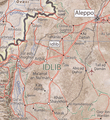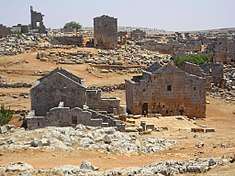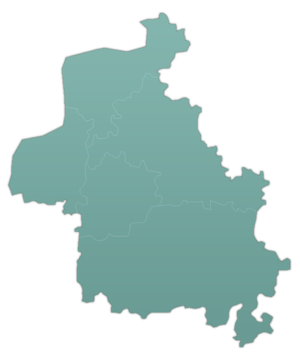Idlib Governorate
Idlib Governorate (Arabic: مُحافظة ادلب / ALA-LC: Muḥāfaẓat Idlib) is one of the 14 governorates of Syria. It is situated in northwestern Syria, bordering Turkey's Hatay province to the north, Aleppo Governorate to the east, Hama Governorate to the south, and Latakia Governorate to the west. Reports of its area vary, depending on the source, from 5,933 km²[1] to 6,097 km².[2] The provincial capital is Idlib.
Idlib Governorate مُحافظة ادلب | |
|---|---|
.svg.png) Map of Syria with Idlib highlighted | |
| Coordinates (Idlib): 35.7°N 36.7°E | |
| Country | |
| Capital | Idlib (rebel control) Ma'arrat al-Nu'man (SAR governor's seat) |
| Manatiq (Districts) | 5 |
| Government | |
| • Governor | fadi saydon |
| Area | |
| • Total | 6,097 km2 (2,354 sq mi) |
| Estimates range between 5,933 km² and 6,097 km² | |
| Population (2011) | |
| • Total | 1,501,000 |
| • Density | 250/km2 (640/sq mi) |
| Time zone | UTC+2 (EET) |
| • Summer (DST) | UTC+3 (EEST) |
| ISO 3166 code | SY-ID |
| Main language(s) | Arabic |
In 2011, the governorate was taken over by rebel militias in the context of the Syrian civil war. In 2017, the governorate territory came under the nominal control of the Syrian Salvation Government, with Tahrir al-Sham becoming the dominant militia in the region. The governorate saw intense fighting in the 2019 Northwestern Syria offensive and subsequent 2020 offensive as government forces advanced deep into the rebel territory; by 29 January 2020 rebel control had been reduced to about 57% of the territory of the governorate.[3] On 8 February that same year, only a little more than half of the governorate's territory was reported to still be under rebel control.[4] The remainder of rebel-held territory is dubbed by publications such as Reuters, the BBC and Agence France-Presse as Syria's "last rebel stronghold".[5][6][7]
History
Archeological sites
- Al-Dana - site of ancient Adennu
- Bara - ancient site
- Ebla - Bronze Age site
- Serjilla - ancient site
- Tell Touqan - ancient site
Modern Syria (1946–2011)
Idlib Governorate was separated from the neighboring Aleppo Governorate on 17 November 1957, during the reign of President Shukri al-Quwatli.[8] In the early 1980s, the Idlib Governorate was one of the focal points of the Islamist uprising in Syria. Jisr ash-Shugur was the scene of a mass killing by Syrian security forces in 1980.[9] On 9 March 1980, against a background of anti-government protests across Syria, inhabitants of Jisr ash-Shugur marched on the local Ba'ath Party headquarters and set it on fire. The police were unable to restore order and fled. Some demonstrators seized weapons and ammunition from a nearby army barracks. Later that day, units of the Syrian Army Special Forces were helicoptered in from Aleppo to regain control, which they did after pounding the town with rockets and mortars, destroying homes and shops and killing and wounding dozens of people. At least 200 people were arrested. The following day a military tribunal ordered the execution of more than a hundred of the detainees. In all, about 150–200 people were said to have been killed.[10]
Syrian Civil War (2011-present)
Idlib contested by Syrian Government and rebels (2011–17)
The Idlib Governorate clashes (September 2011 – March 2012) were violent incidents involving the newly formed Free Syrian Army (FSA) and government-loyal forces, during which the FSA took control of Saraqib, Binnish, Sarmin, Ariha, Zardana, al-Bara and Taftanaz. This included the 10 March Battle of Idlib (2012), a government victory. This led to the April 2012 Idlib Governorate Operation in which the government unsuccessfully sought to regain control. A consequent cease-fire attempt lasted from 14 April to 2 June 2012. This was followed by the Idlib Governorate clashes (June 2012–April 2013), in which the FSA took or regained control of Salqin, Armanaz, Harem, Sarmin, Darkush, Kafr Nabl, Maarrat al-Nu'man and Taftanaz, while government forces maintained control over Jisr ash-Shugur, Fu'ah, Idlib city, Abu al-Duhur airbase and Khan Shaykhun and recaptured Ariha. The Siege of Wadi Deif military base from October 2012 through April 2013 was also broken.
The 2014 Idlib offensive was a series of operations conducted by the rebels against the Syrian Government. The clashes were mostly concentrated around Khan Shaykhun and on the highway towards Maarrat al-Nu'man, and resulted in rebel victory. In the March Battle of Idlib (2015), al-Nusra Front/Army of Conquest-led rebels retook Idlib city from government and Hezbollah forces.[11]
In the Battle of Maarrat al-Nu'man (2016) on 13 March 2016, fighters from the Salafist jihadist groups al-Nusra Front and Jund al-Aqsa launched an overnight attack against the FSA's 13th Division headquarters in the town of Maarrat al-Nu'man to crush local protesters and demonstrations.[12] The battle resulted in a victory for the jihadis. The October 2016 Idlib Governorate clashes were violent confrontations between Jund al-Aqsa and the Syrian rebel group the Ahrar al-Sham, the latter supported by several other rebel groups.
The Idlib Governorate clashes (January–March 2017) were military confrontations between Syrian rebel factions led by Ahrar al-Sham and their allies on one side and the Jabhat Fatah al-Sham (later as Hayat Tahrir al-Sham) and their allies on the other. After 7 February, the clashes also included Jund al-Aqsa as a third belligerent, which had re-branded itself as Liwa al-Aqsa and was attacking the other combatants. The battles were fought in the Idlib Governorate and the western countryside of the Aleppo Governorate.
The Khan Shaykhun chemical attack took place on 4 April 2017, on the town of Khan Shaykhun, then under the control of Hayat Tahrir al-Sham (HTS).[13][14] The town was struck by an airstrike by government forces, which was followed by massive civilian chemical poisoning.[15][16] The release of a toxic gas, which included sarin, or a similar substance,[17] killed at least 74 people and injured more than 557, according to the Idlib health authority.[18] The attack was the deadliest use of chemical weapons in the Syrian civil war since the Ghouta chemical attack in 2013.[19] The United Nations, the governments of the United States, United Kingdom, Turkey, Saudi Arabia, France, and Israel, as well as Human Rights Watch have attributed the attack to the forces of Syrian President Bashar al-Assad.[20][15][21][22] The Assad government denied using any chemical weapons in the air strike.[23]
Predominance of rebels like HTS (2017), Government on the rebound (2019–20)
The Idlib Governorate clashes (July 2017) were a series of military confrontations between Ahrar al-Sham and Hay'at Tahrir al-Sham. During the clashes, Tahrir al-Sham attempted to capture the Bab al-Hawa Border Crossing.[24] As a result of the clashes, HTS took control of Idlib city, the border crossing, and most of the areas along the Turkish border in the Idlib Province. Clashes resumed in July 2017. In September 2017, the Syrian government and its Russian allies intensified bombing raids against rebel-held towns in Idlib, with multiple casualties.[25] Officially, the campaign to capture areas held by ISIL and the rebels began in October. A Turkish military operation in Idlib Governorate took place in October/November 2017.
As of August 2018, following the end of the Siege of al-Fu'ah and Kafriya, which had been government-held until July 2018, the governorate is almost entirely under the control of the Syrian rebels (primarily the National Front for Liberation, which has over 50,000 fighters) along with Hayat Tahrir al-Sham, with estimated numbers of fighters between 12,000 and 30,000).[26][27][28] In September 2018, a demilitarization zone was created on the front between the government and the Turkish-backed opposition, temporarily freezing the conflict.
There are around 20,000-30,000 fighters in Idlib, General Joseph Dunford, chairman of the Joint Chiefs of Staff, explained in July 2019. This was followed by the Deputy Secretary for the Middle East Michael P. Mulroy who explained that "Idlib is essentially the largest collection of al-Qaeda affiliates in the world."[29] Hayat Tahrir al-Sham (HTS), a group linked to al-Qaeda, currently has the upper hand among those fight for control of Idlib. The Institute for the Study of War also warns that Idlib is the focus of a strategy by the ISIS to reconstitute and that Idlib may well be the incubator for the next iteration of IS and al-Qaeda.[29]
On October 26, 2019, U.S. Joint Special Operations Command (JSOC) conducted a raid into the Idlib province of Syria on the border with Turkey that resulted in the death of Ibrahim Awad Ibrahim Ali al-Badri al-Samarrai also known as Abū Bakr al-Baghdadi.[30] The raid was launched based on a CIA intelligence effort that located the leader of ISIS. This complex operations was conducted during the withdrawal of U.S. forces northeast Syria, adding to the complexity.[31][32] The Syrian Democratic Forces and the Iraqi military also supported the operation. Turkey stated that they coordinated with the US prior to the mission.[33]
A large portion of the governorate was retaken by government forces during the course of the Northwestern Syria offensive (April–August 2019) (which caused the displacement of nearly a million civilians) and subsequent 2020 offensive (which caused the death of over 1,000 civilians, often in aerial bombardments). As of March 2020 – if not much sooner – the rebel control over Idlib Governorate is considered a matter of political survival of the Turkish President Erdoğan. If Idlib would fall back into the hands of the Syrian government, the next victims for the Syrian government would be the other Turkish-controlled zones in northern Syria which would imply the bankruptcy of Erdogan's war against Turkey's public enemy number one: the PKK.[34]
As the value of Syrian currency has plummeted, the Turkish lira was adopted as legal tender in the governorate on 15 June 2020.[35]
Geography
Parts of the western-most regions of the governorate form part of the Al-Ghab Plain, through which flows the Orontes river.[36] The region forms a transitional zone between the forested mountains of the western littoral and the Syrian desert to the east. The Jabal Zawiya highland region lies in the south-central areas of the governorate.[37]
Settlements
Idlib is the provincial capital; other major settlements include Abu al-Duhur, Al Hamdaniyah, Ariha, Harem, Jisr al-Shughur, Kafrsajna, Khan Shaykhun, Ma'arrat al-Nu'man, Salqin, Saraqib and Taftanaz.
Districts
The governorate is divided into five districts (manatiq). The districts are further divided into 26 sub-districts (nawahi):
|
|
|
Demographics
As per the 2004 Syrian census the population was 1,258,400.[1] A 2011 UNOCHA estimate put the population at 1,501,000, though this has likely changed since the start of the war.[38]
Gallery
 Map of Idlib governorate
Map of Idlib governorate Ruins of Ebla
Ruins of Ebla
 Salqin
Salqin_Syria.jpg) Byzantine temple in Idlib
Byzantine temple in Idlib Ruins of Serjilla
Ruins of Serjilla
References
- "Syria Provinces". www.statoids.com.
- "Syria: Governorates, Major Cities & Localities - Population Statistics, Maps, Charts, Weather and Web Information".
- "100 hours of military operations in Aleppo and Idlib: nearly 6,000 air and ground strikes, 26 areas fall to regime forces, and over 60,000 civilians displaced". Syrian Observatory for Human Rights. 29 January 2019.
- "Syria army takes Idlib crossroads town despite Turkish warnings". AFP.com. Retrieved 2020-02-08.
- "Russia holds key to Idlib's fate as Syrian army advances". Reuters. 2020-02-07. Retrieved 2020-02-08.
- "Syrian army 'recaptures' key town from opposition". BBC News. 2020-01-29. Retrieved 2020-02-08.
- "Syria army takes Idlib crossroads town despite Turkish warnings". AFP.com. Retrieved 2020-02-08.
- "وثيقة رسمية تكشف: إدلب قبل عبد الناصر". Orient News (in Arabic). 14 January 2020.
- Seale, Patrick (1990). Asad of Syria : the struggle for the Middle East. Berkeley: University of California Press. p. 327. ISBN 0-520-06976-5.
- Human rights in Syria. Human Rights Watch. 1990. pp. 16–17. ISBN 0-929692-69-1.
- "Gulf allies and 'Army of Conquest". Al-Ahram Weekly. 28 May 2015.
- "Division 13 evacuate most of its headquarters in the southern countryside of Idlib and clashes between them against Jabhat Al-Nusra and Jund al-Aqsa in Maarrat al-Nu'man area and tension prevails in the area". Syrian Observatory For Human Rights. 2016-03-13. Retrieved 2016-03-14.
- SOHRkhan (14 February 2017). "اشتباكات هيئة تحرير الشام وتنظيم جند الأقصى تخلف نحو 70 قتيل بين الطرفين… والأخير يخسر 9 بلدات وقرى خلال الـ 48 ساعة الفائتة". Syrian Observatory for Human Rights. Retrieved 5 April 2017.
- "Search for the dead begins in Idlib after Islamic State-linked brigade leaves for Raqqa". Syria Direct. 22 February 2017. Retrieved 5 April 2017.
- "Syria chemical 'attack': Russia faces fury at UN Security Council". BBC. 5 April 2017. Retrieved 5 April 2017.
- "Witness of Syria chemical attack gives graphic account as death toll climbs". www.thenational.ae. 6 April 2017. Retrieved 10 April 2017.
The warplane dropped three conventional explosive bombs – and a fourth that made little sound on impact but produced a cloud of smoke.
- "Syria war: Sarin used in Khan Sheikhoun attack, OPCW says". BBC News. 2017-04-20. Retrieved 2017-04-20.
- "Idlib town reels following major chemical attack: 'No rebel positions, just people'". Syria:direct. 5 April 2017.
- "Syria 'toxic gas' attack kills 100 in Idlib province". Al-Arabiya & AFP. 4 April 2017.
- Theodore Schleifer and Dan Merica. "Trump: 'I now have responsibility' when it comes to Syria". CNN. Retrieved 5 April 2017.
- "US attack on Syria: world leaders react". The Irish Times. 12 April 2017.
- "An official source at Foreign Affairs Ministry expresses Kingdom of Saudi Arabia's strong support for US military operations on military targets in Syria". 12 April 2017.
- "Syria's Assad says chemical attack '100 percent fabrication'". Agence France Presse. 13 April 2017.
- "Fighting in Syria's Idlib province spreads to Turkey border crossing". The National.
- Suleiman Al-Khalidi Russia, Syria intensify bombing of rebel-held Idlib, witnesses say, Reuters, 24 September 2017
- "Syria: Who's in control of Idlib?". BBC News. 7 September 2018. Retrieved 22 October 2018.
- Joe Macaron (17 October 2018). "A confrontation in Idlib remains inevitable". Al-Jazeera. Retrieved 27 October 2018.
- "A Jihadist Breakup in Syria". Foreign Affairs. 2017-09-15. ISSN 0015-7120. Retrieved 2017-09-25.
- Review, Week in (July 19, 2019). "While the world focuses on Iran, a tragedy is 'unfolding before our eyes' in Idlib". Al-Monitor. Archived from the original on July 20, 2019. Retrieved July 20, 2019.
- "Archived copy". Archived from the original on 2019-10-27. Retrieved 2019-10-27.CS1 maint: archived copy as title (link)
- "Archived copy". Archived from the original on 2019-10-27. Retrieved 2019-10-27.CS1 maint: archived copy as title (link)
- "Archived copy". Archived from the original on 2019-10-27. Retrieved 2019-10-27.CS1 maint: archived copy as title (link)
- "Archived copy". Archived from the original on 2019-10-27. Retrieved 2019-10-27.CS1 maint: archived copy as title (link)
- (in Dutch) 'For Erdogan, Idlib is kill or cure'. NRC Handelsblad, 4 March 2020. Retrieved 7 March 2020.
- AGENCIES, DAILY SABAH WITH (2020-06-16). "Idlib follows suit in adopting Turkish lira to shield region from plummeting Syrian pound". Daily Sabah. Retrieved 2020-06-16.
- "Asi-Orontes Basin". Food and Agriculture Organization of the United Nations. 2016. Retrieved 18 March 2018.
- "Moderate opposition controls Zawiya Mountain in Syria". Anadolu Agency. 2 March 2020. Retrieved 24 March 2018.
- Syrian Arab Republic - Governorates profile (PDF), UNOCHA, June 2014, retrieved 20 March 2020
External links
| Wikimedia Commons has media related to Idlib Governorate. |
- Olly Lambert (April 9, 2013). "Syria Behind the Lines". Frontline. USA: Public Broadcasting Service. (Film about Syrian Civil War in 2012 in the Idlib area)
